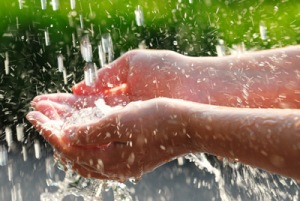We turn on the tap…it’s there. We flush…it’s out of our lives. We leave the hose on all night…no big deal.We get our water bill…it doesn’t hurt.
The cost of municipal water hovers just above $4 per 1000 gallons in suburban Atlanta, GA where I live. It doesn’t take a math wiz to know that’s less than .4 cents per gallon. And I think that’s just too cheap.
 Right now Georgia is still in the midst of a 30-year-old water-rights war with Florida and Alabama over the contents of the 38,000 acre Lake Lanier. A federal ruling by U.S. District Judge Paul Magnuson in 2009 had drawn a line in the sand. The ruling gave the three states until 2012 to get an agreement together or face a forced reversion to 1970 water distribution levels—an action that would leave thirsty metro Atlanta with a mere trickle of the Lake’s resources. In two years Atlanta could no longer use Lake Lanier for drinking water? A travesty! An injustice! Or an opportunity?
Right now Georgia is still in the midst of a 30-year-old water-rights war with Florida and Alabama over the contents of the 38,000 acre Lake Lanier. A federal ruling by U.S. District Judge Paul Magnuson in 2009 had drawn a line in the sand. The ruling gave the three states until 2012 to get an agreement together or face a forced reversion to 1970 water distribution levels—an action that would leave thirsty metro Atlanta with a mere trickle of the Lake’s resources. In two years Atlanta could no longer use Lake Lanier for drinking water? A travesty! An injustice! Or an opportunity?
Desperate Times Calling
My hope in the federal ruling was that—as a community—we’d take notice, realign our perspective and take corrective action. My hope was that this legally imposed crisis would bring about a change in our attitudes toward water—and more importantly, our consumption of it. I’m not sure that happened. The ruling is over a year old and I still find many friends and neighbors who don’t know a thing about it. I’m firmly convinced that most people wouldn’t know or care until one morning their faucets didn’t come on to wet their toothpaste. How did this happen?
The reality is that—whether by federal ruling or not—we’ll face a true water crisis at some point in the future. The water squabbles have been going on for 30 years, afterall. There is just not enough water to go around…at least not at the rate we use it now. Magnuson’s ultimatum at least gave us a test of the status quo—an opportunity to change our ways and prepare for the true crisis. I don’t think it worked.
Put the Money Where the Tap Is
The only way that people will ever change their water consumption habits is when they pay more. Water is just too cheap at .4 cents a gallon, so we treat it like it’s cheap. A few days ago I walked over to a neighbor’s house a to pay her son for mowing my lawn and found her washing the dog. She dropped the hose—running full blast down the driveway—to go find her son. Six to Eight gallons per minute for three minutes, it didn’t even cost her a dime. But, if it was going to cost her a $1.50, she might have stopped to turn off the hose. I’m a little ashamed I didn’t do it myself, but I felt like a scientist observing the habits of the American Water Consumer in their natural habitat.
So, how is the American Water Consumer convinced they need to pay more for the resource they’ve grown accustomed to see as a fundamental right? I’ll tackle that in another post.
Thanks for reading. I’m hot for water…you can be too.